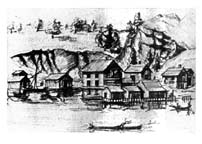 "A Center for Sin, Under-the-Hill Natchez", drawing by a visiting Frenchman, 1809, archives of Natchez Historical Society |
Natchez
Mississippi Territory |
 "A Center for Sin, Under-the-Hill Natchez", drawing by a visiting Frenchman, 1809, archives of Natchez Historical Society |
Natchez
Mississippi Territory |
The Mississippi Territory was first explored by Hernando de Soto in 1541 while searching for gold. In 1682 the Frenchman, Robert Cavalier, Sieur de la Salle, came down from Canada through the Great Lakes down the Mississippi River. He claimed and named as "Louisiana" the entire Mississippi River valley for Louis XIV. The first French settlement was established by Pierre le Moyne, Sieur de Bienville, at Old Biloxi in 1699. A second settlement was established by Jean Baptiste le Moyne at Fort Rosalie, now Natchez. In 1719 the first negro slaves were brought to the area to work the rice and tobacco crops.
There were many battles for control of the territory against the Indians, the Spanish and the British. After the French and Indian War (1754-1763) and the Treaty of Paris gave the British control of the land east of the Mississippi. During the Revolutionary War this region was known as an area of loyal British settlers. In 1781, the British paid little attention to the far western region and the Spanish took over this region known as West Florida. After the American Revolution the United States now entered the picture and made a treaty with Spain using the 31st parallel as the boundary. The new territory became the Mississippi Territory in 1798 with Natchez as the capital.
The main transportation to get to Natchez was by the Mississippi River. Early settlers took canoes the several hundred miles south. The only road was hardly a road at all, much more like a trail. It was was known as "The Path of the Choctaw Nation." Eventually this path was converted into the Natchez Trace, a road over which wagons could be pulled all the way from Nashville, Tennessee. Settlers after the Revolution often times had flatboats built in places such as Nashville. They could load all their goods and small animals on board and float leisurely down the river. They stopped each night to prevent running into deadheads, sandbars and other debris. Large animals had to go overland often with great loss due to natural dangers and marauding whites and natives.
Many settlers who came here shortly after the Revolution were Loyalists who had sold their property at deep discounts. They converted the money gained from their sales into a portable commodity, slaves. Large numbers of slaves were brought to Natchez where they were sold to the prospering rice and tobacco plantation owners. The money gained then could then be reinvested in land in the rich Mississippi River flood plain. Anything left over went to purchased livestock, slaves or buildings. Cash was almost always deeply discounted and gold which was scarce was also subject to thieves. Land prove to be the most stable form of investment. The first bank was not attempted until 1809.
The river provided Natchez with an extremely varied and lively assortment of visitors and settlers. Although several churches and missionaries had formed groups of supporters among the new settlers, below the hill another life existed with gambling, brothels and other illegal activities. Andrew Ellicott stated to Sir William Dunbar that the Natcheens were "as difficult a people to govern as Moses did the Children of Israel." As one of the main towns on the edge of the wilderness many adventurers came through here such James Audubon, Andrew Jackson in his early career and James Bowie, who later died in the Alamo. James Bowie, after a duel in which he was supposed to be a by stander on a sand bar near Natchez, was shot and while recooperating made a wooden model of the now famous Bowie knife. In the temporary capital of the territory, the neighboring town of Washington, was held the first trial for treason of Aaron Burr. After being acquitted here he was retried in a different location.
My own relative, John Hollaway, came here with his wife, Elizabeth (White), and several children by canoes. John Hollaway was shortly followed by several White family members, brothers and sister-in-laws of Elizabeth. Before they arrived, however, John Hollaway was said to have been killed by Indians. He may have actually been killed by some of the local thugs in a robbery gone bad. Elizabeth had to find a means to take care of her brood and rather quickly marries to John Stillee. Her life was never easy as John Stillee and her seemed to be rather constantly fleeing from their debts. Most of her children survive to marry some of the more prominent citizens and have many children of their own. Almost all moved to settle other frontiers in Louisiana and Arkansas. Other names in association with the Hollaway and Whites at the turn of the century include the Beck, Porter, and Wells families.
sources:







All information and photos
included within these pages was developed by the help of hundreds of
researchers. The information here is for the express purpose of
personal genealogical research and is freely offered as long as this
site is listed as a source. It may not be included or used for any
commercial purpose or included in any commercial site without the
express permission of Elroy Christenson. Copyright Elroy Christenson
1998-2010.